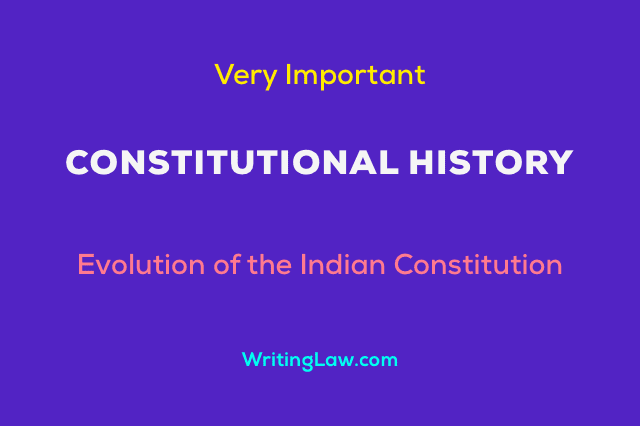
The Constitution of India was an outcome of long-lived historical events. To make India a republican country was the combined effort of all national leaders and constitution-makers. It took 2 years, 11 months, 18 days to complete the Constitution. Look at this law note that tells you about the Constitutional History of India – how things started in 1773 to gaining independence in 1947.
Evolution of Indian Constitution – Constitutional History
- Regulating Act, 1773
- Pitts India Act, 1784
- Charter Act, 1813
- Charter Act, 1833
- Government of India Act, 1858
- Indian Council Act, 1861
- Indian Council Act, 1892
- Act of 1909 (Minto Morley Reforms)
- Act of 1919 (Montagu Chelmsford Reforms)
- Government of India Act, 1935
- Cripps Mission
- Cabinet Mission Plan
- Indian Independence Act, 1947
Regulating Act, 1773
- Due to increasing corruption in the East India Company, it came under the direct control of the British parliament.
- Governor of Bengal became the Governor-General of Bengal.
- Warren Hastings became the first Governor-General of Bengal.
- In Calcutta, Supreme Court was established.
Pitts India Act, 1784
- A board of control was established for carrying out political responsibilities under the British government.
- East India Company became more responsible towards the British government.
Charter Act, 1813
- The councils of Bombay, Madras, and Calcutta were empowered with more powers.
- The local bodies in provinces were authorized to levy taxes from people.
Charter Act, 1833
- Governor-General got empowered with more powers. The matters related to revenue were now under the control of the Governor-General.
- This act was a step towards centralization.
- The Governor-General of Bengal now became the Governor-General of India.
- The first Governor-General of India was William Bentick.
- Christian institutions had entered India by that time.
Government of India Act, 1858
- The Act was passed by the Parliament of England.
- Company’s rule came to an end, and the administration of India came under the direct control of the Crown.
- Secretary of state for India was established, who would be a member of the British Cabinet.
- Sir Charleswood was the first Secretary of State for India.
- Now the Governor-General of India became the Viceroy of India. Lord Canning was the first Viceroy.
Indian Council Act, 1861
- This Act was passed after the revolt of 1857.
- A provision was made for the inclusion of Indians in the executive council. Out of 6 to 12 additional members, half of them were to be Indians.
- Three Indians who were nominated for the council by Lord Canning were Raja of Banaras, Maharaja of Patiala, and Dinkar Rao.
- High Court Act was also passed in the year 1861 for establishing High Courts in Bombay, Madras, and Calcutta.
Indian Council Act, 1892
- There was the establishment of Congress in the year 1885.
- The demand was raised for administrative reforms, political reforms, social reforms, and economic reforms.
- This Act came up with the beginning of the Indian Civil Services Exam.
Act of 1909 (Minto Morley Reforms)
- The principle of election was legally recognized by the legislative council.
- Separate electorate was given to Muslims but Jinnah opposed communal representation.
- The councils were given the right to discuss, pass resolution on the budget, but Governor-General had the power to disallow discussion.
Act of 1919 (Montagu Chelmsford Reforms)
- The concept of Dyarchy was introduced in the provinces.
- The provincial subjects were divided into reserved and transferred subjects respectively. Reserved subjects like police, jail, etc. And transferred subjects like education, sanitation, and so on.
- A High Commissioner for India at London was appointed.
- Bicameral legislature got set up at the centre consisting of council of states and legislative assembly.
Government of India Act, 1935
- In the Simon Commission Report of 1927, Jinnah demanded a separate electorate in Constitution. This was the stage when the seed of separation and communalism flourished actually.
- All India Federation was established at the centre consisting of British India and princely states.
- Separation of powers into three lists as federal, provincial, and concurrent (Presently in the Seventh Schedule of the Constitution.)
- Dyarchy was abolished. The act gave more autonomous powers to the provinces for better administration. The governor was made head of the provincial executive.
Cripps Mission
- In 1942, Sir Stafford Cripps came with the proposal to frame the Constitution by elected Indian members of the Constituent Assembly.
- The proposal was to give India dominion status through the Constitution. And those provinces which want to remain free and not to accept the Indian Constitution could maintain a separate position.
Cabinet Mission Plan
- The purpose of the mission was to make India independent and form a constituent assembly for framing the Constitution.
- The mission showed disagreement on the separate electorate for Muslims and separate Constituent Assembly.
- All residuary powers to be vested in the provinces and the states (Presently, residuary power vests in the parliament under Article 248.)
- Any communal dispute or issue in the legislature was to be resolved by the majority support of each two major communities present and voting as well as a majority of the members present and voting.
Indian Independence Act, 1947
- After 15th August 1947, India shall no longer be a dependent state of the British Crown.
- The Central legislature of India ceases to exist after 14th August 1947. After independence, the Constituent Assembly shall function as the Central Legislature.
Read Next:
1. Fundamental Duties Explained
2. 5 Ways of Acquiring Citizenship of India
3. Why 42nd Amendment Is Called the “Mini Constitution of India”
4. Citizenship Amendment Act, 2019 Explained with Pros and Cons
- Article 334A of the Constitution of India - 14th April 2024
- Article 332A of the Constitution of India - 14th April 2024
- Article 330A of the Constitution of India - 14th April 2024






